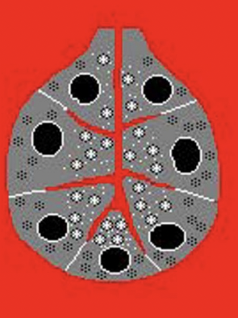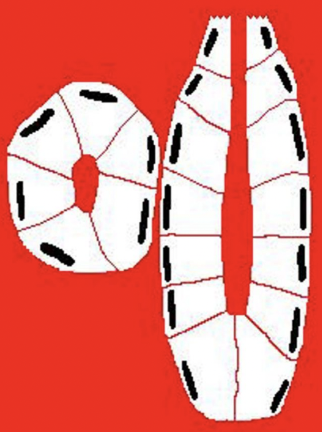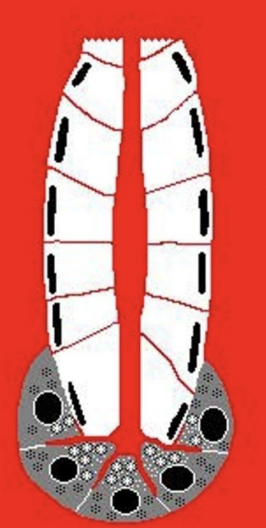Histology 1.2 (glandular epithelium exocrine glands)
1/17
There's no tags or description
Looks like no tags are added yet.
Name | Mastery | Learn | Test | Matching | Spaced |
|---|
No study sessions yet.
18 Terms
Glandular epithelium + types
Cells specialized to produce secretion (release of products by exocytosis)
2 types:
Exocrine glands:
Excretory ducts that deliver to a specific site
Gland product is released on surface
Endocrine glands:
Blood systematic circulation
Gland product is released in blood
6 Principles of Exocrine gland classification
Number of cells
Site of cells
Shape of the terminal secretory unit
Branching of the terminal secretory unit and collecting ducts
Modes of secretion
Nature of secretion
Number of cells:
Unicellular
Ex. goblet cells (contain mucinogen droplets that +H2O = mucus)
Important because mucus produced protects organs such as small intestine
Multicellular
Sweat and sebaceous glands (ex. skin, hair)
Intraepithelial glands in many organs (ex. uterus, urinary & respiratory tract)
Constitute separate organs (ex. pancreas, salivary and mammary gland)
Site of glands
Only applies to multicellular glands:
Intramural glands
Within an epithelium, consist of a secretory unit and a excretory duct
Extramural glands
Constitute a separate organ, (ex. pancreas)
Shape of terminal secretory duct (secretory unit)
Tubular gland (longer tube shape)
Alveolar gland (shorter, circular shape)
Methods of cutting tubules
Cross section — horizontal
Oblique section — diagonal
Longitudinal section — vertical
Branching of secretory units and collecting ducts
(secretory units attached to collecting ducts)
Branching of secretory units
Simple (1 unit) (only in simple)
Simple branched
Do not mention in compound
Branching of collecting ducts
Simple = no duct branch
Compound = 1+ duct branch
Overview of naming exocrine glands
Simple = 1 unit 1 duct
Simple Branched = 1+ units 1 duct
Compound = 1+ units 1+ ducts
Mode of secretion
Merocrine
Thin granules are secreted from cell with cell remaining intact
Apocrine
Portions/drops of the membrane are pinched off and released, with cell remaining otherwise intact
Holocrine
The whole cell disintegrates and thus releases the product
Remaining cells divide to reconstitute the gland
Nature of secretion
Serous
Usually merocrine secretion
Round structure, round nuclei
Mainly produces proteins
Watery fluid secretion
Mucous
Usually apocrine secretion
Predominance of carbohydrates
Viscous secretion (thus elongated structure)
Everything is squeezed to the bottom because of mucinogen granules
Mixed
Contains some cells producing proteins and other cells producing mucous

Serous nature of secretion

Mucous nature of secretion

Mixed nature of secretion (both mucous and serous)
Myoepithelium
Specialized squamous epithelial cells with power of contraction
Surrounds glandular acini and ducts of many glands
Contains actin, myosin, and cytokeratin
(Epithelial in origin, not muscle)
Pancreas
Endocrine (islets of Langerhans)
Exocrine pancreas:
Produces digestive secretions that are discharged into the duodenum via an extensive system of ducts
A compound tubulo-acinar gland composed of serous secretory cells
Groups of acini form lobules, which are separated by connective tissue
Pancreatic Acinus
Simplest secretory unit (a blind sac)
Acinus lumen continues with a collecting duct called the intercalated duct
Smallest, continues to larger ducts in the lobule called striated ducts
Found in basal infoldings, mitochondria, and ion transporting cells (where they function to modify final electrolyte concentrations)
Lobule
Many acini and their ducts
Many lobules form a lobe in the gland
Collecting ducts from multiple lobes join together in the major pancreatic duct — the Wirsung duct, which arrives in the duodenum
How to tell between serous or mucous in an image
Serous:
Nuclei everywhere
Mucous:
Nuclei are smushed against the membranes because they are pushed away by the mucinogen granules